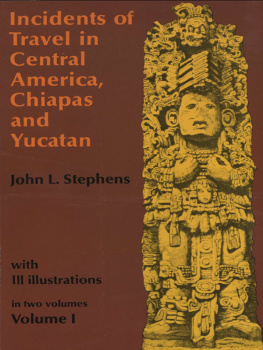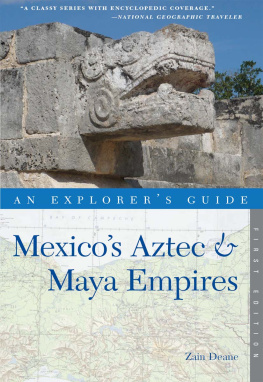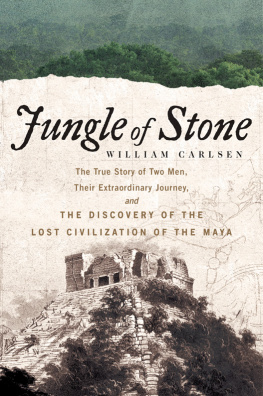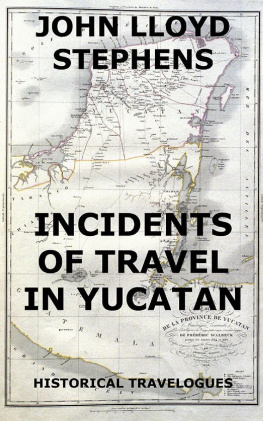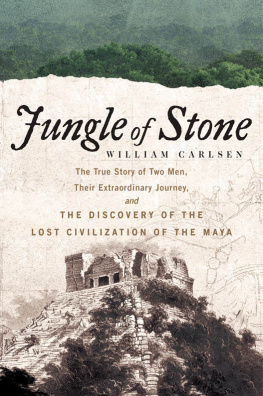
STONE IDOL THIRTEEN FEET HIGH, AT COPAN.
Incidents of Travel in
CENTRAL AMERICA
CHIAPAS AND
YUCATAN
By JOHN L. STEPHENS
WITH ILLUSTRATIONS BY
FREDERICK CATHERWOOD
IN TWO VOLUMES
Volume I
DOVER PUBLICATIONS, INC.
NEW YORK
Copyright 1969 by Dover Publications, Inc.
All rights reserved under Pan American and
International Copyright Conventions.
This Dover edition, first published in 1969, is an unabridged republication of the work originally published in 1841 by Harper & Brothers, New York, to which has been added certain material (as specified in the Publishers Note) from the edition published by Arthur Hall, Virtue & Co., London, in 1854.
Standard Book Number: 486-22404-X
Library of Congress Catalog Card Number: 74-95745
Manufactured in the United States of America
Dover Publications, Inc.
180 Varick Street
New York, N.Y. 10014
PUBLISHERS NOTE
______
THIS edition is an unabridged republication of the first edition as published by Harper & Brothers, New York, in 1841. Captions have been supplied for those illustrations formerly lacking them. The following material, first published in a revised and abridged edition of the work prepared by Frederick Catherwood and published in 1854 by Arthur Hall, Virtue & Co, London, has been introduced into the present edition: (1) the Biographical Notice following this Note; (2) the illustrations in Volume One on pages 50 and 85 and facing pages 166, 267 and 290, and in Volume Two on page 419 and facing pages 274 and 336. The Lists of Illustrations to both volumes have been altered accordingly.
The large foldout map of the 1841 edition has been replaced by the more compact version (Volume One, facing page 10) from the edition of 1854. The portrait overleaf is also new to this edition.

JOHN LLOYD STEPHENS (18051852)
BIOGRAPHICAL NOTICE.
______
A SHORT biographical notice of my late fellow-traveller may not be uninteresting to the readers of the present volume. Mr. John Lloyd Stephens, the second son of Mr. Benjamin Stephens, was born at Shrewsbury in the State of New Jersey, in the United States of America, in the year 1805. Until the age of thirteen, Mr. Stephens studied at the school of Mr. Nelson, who, although blind, is described as an admirable teacher of the classics. For four years Mr. Stephens pursued his studies at Columbia College, New York, afterwards entered a law school, and when of age was admitted to the practice of the legal profession.
In the year 1834, the state of Mr. Stephenss health rendering it necessary for him to travel abroad, he visited many of the countries of Europe, extending his tour to Egypt and Syria. On his return to New York, he published Incidents of Travel in Egypt, Arabia, Petra, and the Holy Land, followed very shortly by Incidents of Travel in Greece, Turkey, Russia, and Poland.
These works were received with great favour, and were very extensively read in the United States; and in this country have been several times reprinted, establishing Mr. Stephenss reputation as an excellent and agreeable writer of Travel and Narrative.
In 1839 Mr. Stephens and myself made arrangements for a tour in Central America, with a view to the examination of the remains of ancient art said to exist in the dense forests of those tropical regions.
Our preparations were scarcely completed, when Mr. Leggett, who was on the point of setting out as United States Minister for that country, died very suddenly, and upon application for it, Mr. Stephens immediately received the appointment. We had some misgivings lest it should interfere with our antiquarian pursuits, but Mr. Stephens contrived, as the reader will find, to combine the chase after a Government with a successful hunt for ruined cities. Our journey occupied about seven or eight months of the years 1839 and 1840. The results of our researches were published in 1841. In the autumn of that year, we resumed our travels, and explored the Peninsula of Yucatan, and in 1843 a second work was brought out. After our last visit to Yucatan, we were urged to pursue the researches so successfully carried on in Central America by a journey to Peru, and Mr. Prescott, the admirable historian of that country, was of opinion that much useful information would thereby have been elicited. Mr. Stephens was, however, disinclined to undertake so distant an expedition, and was confirmed in this resolve by my being obliged to absent myself for several years on a professional engagement in the West Indies; he therefore remained in New York, and undertook the formation of the first American Ocean Steam Navigation Company, which in the end has proved highly successful. He next visited the Isthmus of Panama, with the view of forming a Railway across the narrow but difficult neck of land that separates the Atlantic and Pacific Oceans.
A Company was formed, of which he subsequently became the President, and a concession for the line was obtained from the Government of New Grenada. The necessary surveys were made, and the works began in 1850. Having completed my engagement in the West Indies, I rejoined Mr. Stephens to assist in his great enterprise of spanning the Isthmus with a road of iron, and took charge of the works while he made a second journey to Santa F de Bogot, the capital of New Grenada. We expected to meet in a few months, but Mr. Stephenss health, already much shattered by exposure in tropical regions, and mine still more so by a seven months residence in one of the most unhealthy climates in the world, separated us for nearly two years; Mr. Stephens going to New York to recruit his strength, and I to California for the same object. Subsequently Mr. Stephens returned to the Isthmus, and by long and incautious exposure in that deadly climate in forwarding the interests of the Railway Company, brought on a disease which terminated fatally in the autumn of 1852.
As his fellow-traveller and intimate friend, I may be permitted to bear testimony to his kindly disposition, and the many excellent qualities of head and heart which endeared him to a large circle of friends and connexions.
F. CATHERWOOD.
PREFACE.
________________________
THE author is indebted to Mr. Van Buren, late President of the United States, for the opportunity of presenting to the public the following pages. He considers it proper to say, that his diplomatic appointment was for a specific purpose, not requiring a residence at the capital, and the object of his mission being fulfilled or failing, he was at liberty to travel. At the time of his arrival in Central America, that country was distracted by a sanguinary civil war, which resulted, during his sojourn there, in the entire prostration of the Federal Government. By the protection and facilities afforded by his official character, he was enabled to accomplish what otherwise would have been impossible. His work embraces a journey of nearly three thousand miles in the interior of Central America, Chiapas, and Yucatan, including visits to eight ruined cities, with full illustrations from drawings taken on the spot by Mr. Catherwood. Its publication has been delayed on account of the engravings; but on one consideration the author does not regret the delay. Late intelligence from Central America enables him to express the belief that the state of anarchy in which he has represented that beautiful country no longer exists; the dark clouds which hung over it have passed away, civil war has ceased, and Central America may be welcomed back among republics.
Next page
